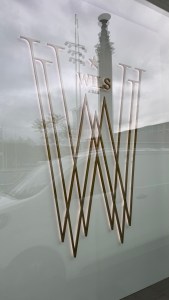
Wils is a Michelin-starred restaurant located just outside Amsterdam’s Olympic Stadium. It takes its name from Jan Wils, the architect who designed the stadium for the 1928 Olympic Games. In the photo above, showing the restaurant’s exterior window with its logo, you can see the reflection of the stadium’s iconic tower—where the Olympic flame once burned during the Games.
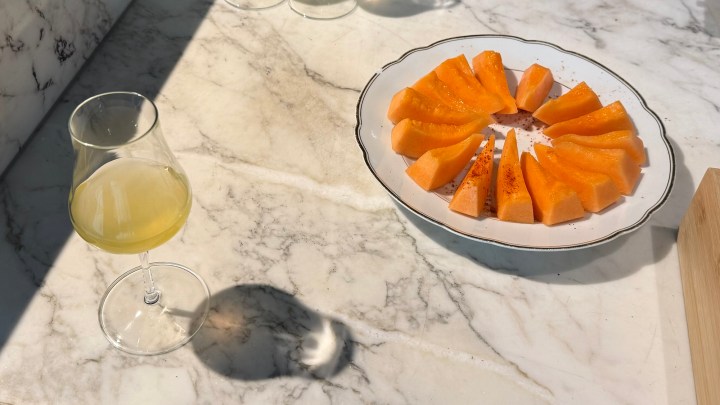
Upon arrival, we were offered a glass of kombucha with a slice of cantaloupe melon topped with Moroccan spices. The kombucha was extremely acidic—it made me cough, and I didn’t finish my glass. We had a look at the restaurant’s roof garden, where they grow their own herbs and some fruits.
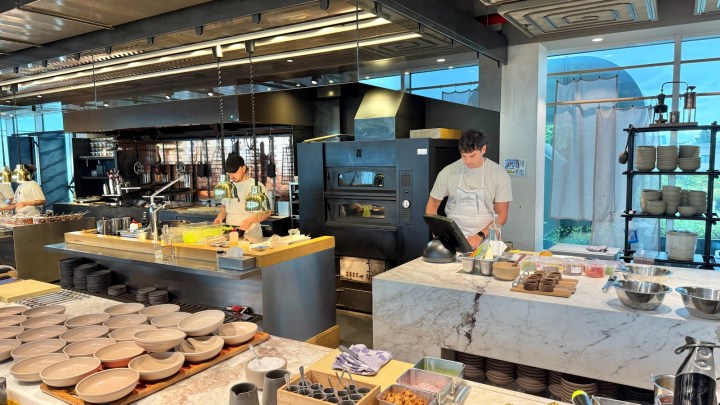
The open kitchen at Wils prominently features a charcoal fire, as a homage to the Olympic flame. The grill plays a central role in many of the dishes. We were seated at the kitchen bar, which gave us a close-up view of the chefs at work. While we enjoyed this vantage point, it hadn’t been mentioned during the reservation process. Not all seating is at the bar; the restaurant also offers standard table arrangements.
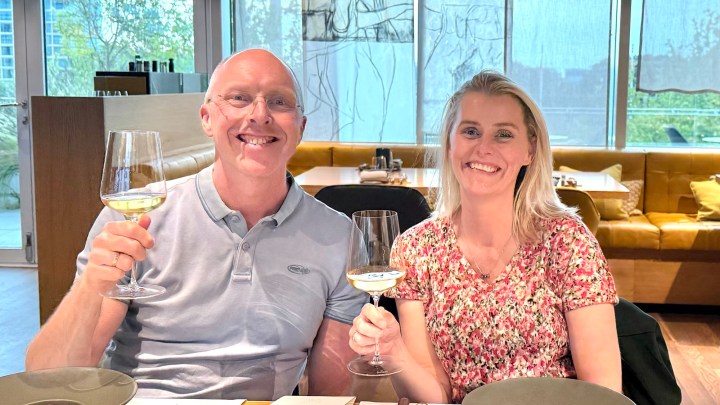
I took my friend Anja to celebrate her birthday, part of a tradition I started a few years ago with five of my closest friends. The restaurant offers both a chef’s menu—six courses for €115, with a wine pairing for €95—or à la carte options. We chose the chef’s menu with wine pairing. Wils offers 21 wines by the glass, including some exclusive selections served via Coravin. The wines from the pairing are drawn from this list. I asked to upgrade the standard pairing if a more exclusive wine would complement a dish well, specifically mentioning the enticing 2016 Chassagne-Montrachet 1er Cru as I love good white Burgundy.
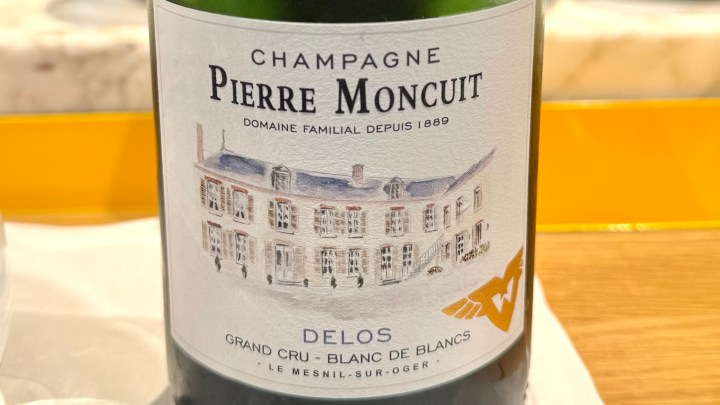
We started with a glass of sparkling wine; I had a Blanc de Blancs Grand Cru Champagne made entirely from Chardonnay, which was quite enjoyable.
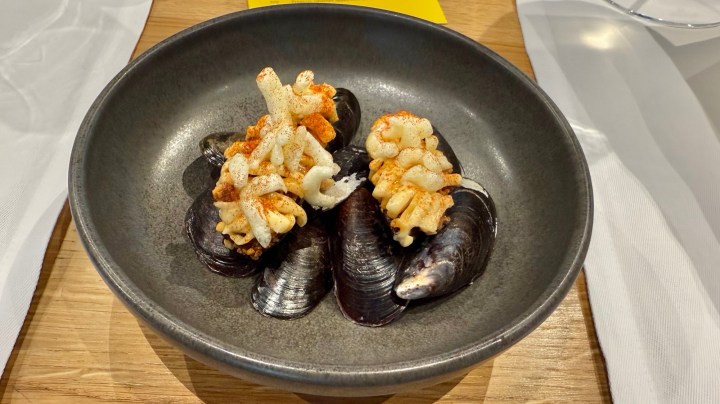
The restaurant didn’t offer any amuse-bouches, but instead presented a list of ‘bites’ available for order—a trend that seems aimed at keeping the chef’s menu price lower. We chose the mussel croquettes, which turned out not to be traditional croquettes but mussel shells filled with a creamy mussel and herb mixture, topped with a crunchy topping.
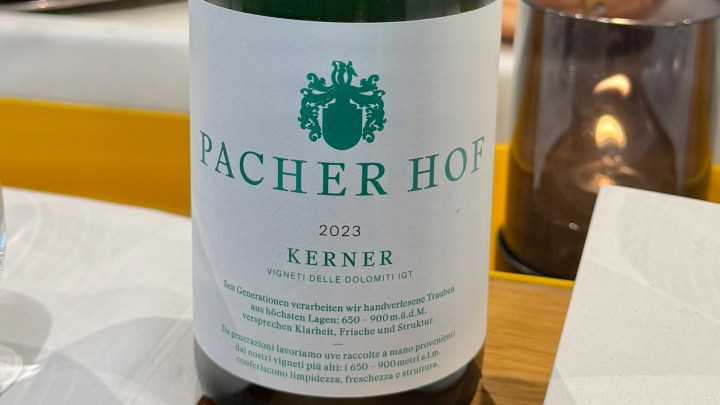
The first wine in the pairing was a Kerner from the Dolomites in Italy—a grape variety not often encountered. A cross between Riesling and Schiava, it had a floral character reminiscent of Riesling but with softer acidity.

This was a good pairing for the dish of sweet, crunchy peas with basil and tomato, accompanied by grilled baby lettuce and a sliver of lardo. The richness of the lardo balanced beautifully with the freshness of the vegetables.
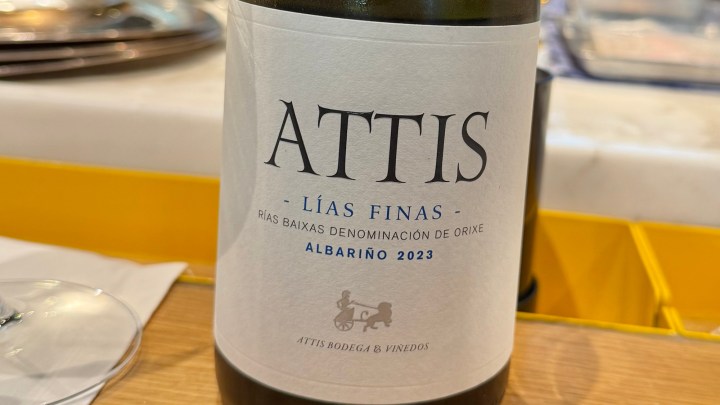
We continued the wine pairing with an Albariño from Rías Baixas in Spain, aged for six months on the lees—partly in stainless steel and partly in oak barriques. This aging process gave the wine a creamy texture and a golden hue.
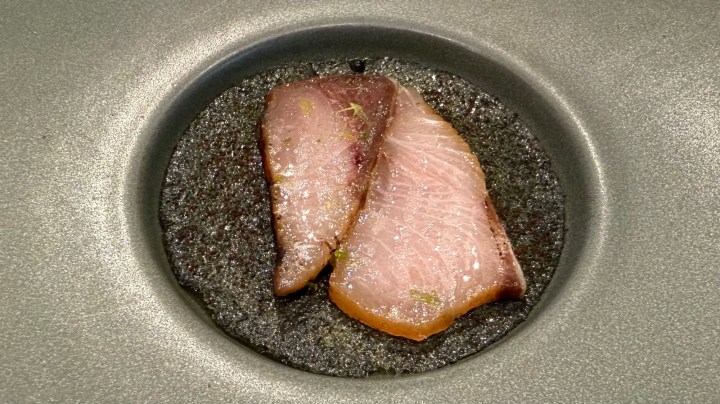
This was a good pairing for the hamachi, which was cured with coffee and served alongside hamachi belly tartare with sambal and coconut. When I think of sambal, I usually expect the heat of sambal oelek, but this version wasn’t spicy at all. A crunchy sheet added a pleasant contrast in texture.
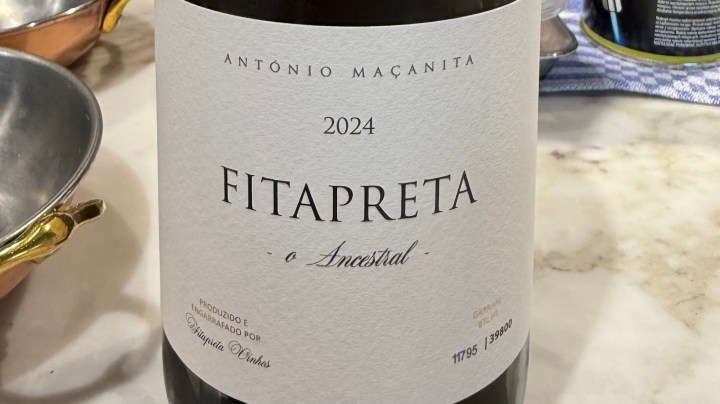
The third wine was a white blend from Alentejo in southern Portugal. The sommelier introduced it as an Arinto, but it didn’t taste as fruity as I’d expect from a pure Arinto. I didn’t want to interrupt dinner with Anja by looking it up, but a quick search afterwards confirmed my suspicion: it was actually a blend of Alicante Branco, Arinto Tamarez, Rabo de Ovelha, and Roupeiro.
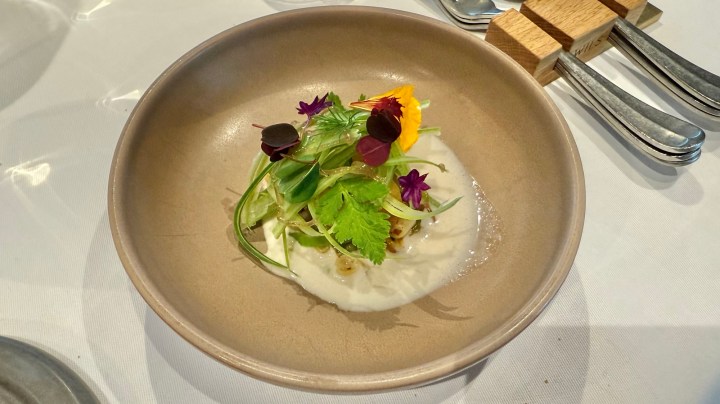
The wine may have been a bit too expressive for the next dish: raw shaved green beans with almond and underripe peach. A delicate vegan creation with very subtle flavors.
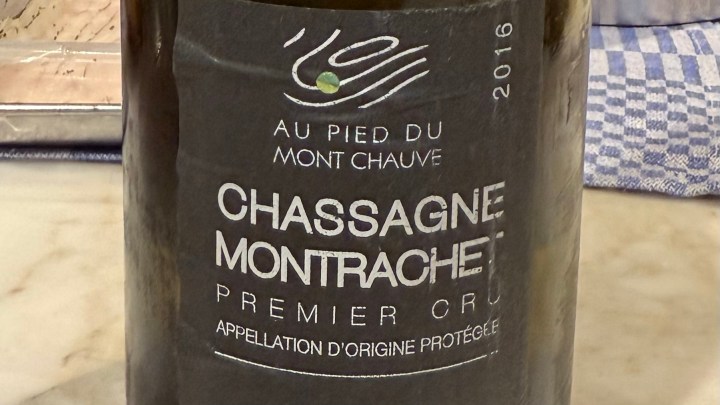
The regular wine pairing for the next dish was a Gewürztraminer orange wine from Niagara Falls, Canada, but this was the moment I received my upgrade to the 2016 Chassagne-Montrachet 1er Cru. The smallest quantity of oak-aged wine that can be produced is one barrel, which in Burgundy is 228 litres, or 304 bottles. Due to the low yield in this vintage, the winemaker couldn’t vinify the individual Premier Cru vineyards of Chassagne-Montrachet separately (as each vineyard was less than a whole barrel), and instead created a generic 1er Cru. The wine was aged for 18 months on the lees, including 10 months in oak. It’s a rich style with excellent minerality and balance.
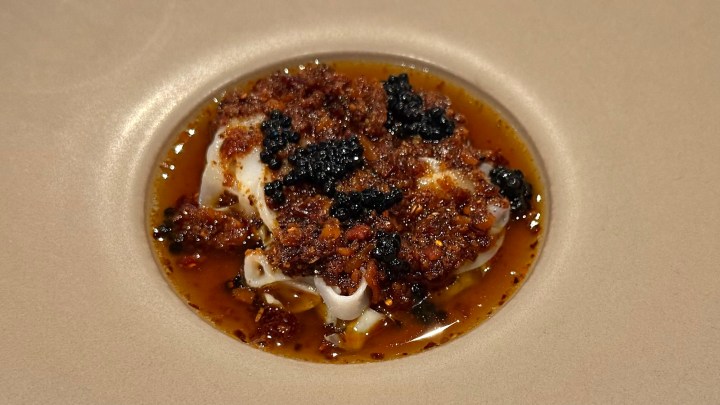
It was an adequate pairing for the thinly sliced cuttlefish with cabbage and gochujang—a Korean paste made from rice, soy, and chili. The cuttlefish and cabbage contributed mostly texture, while the gochujang dominated the flavor profile. It was a challenging dish to pair with wine due to its bold spiciness and unctuous texture. The orange Gewürztraminer (which Anja had) was quite tannic and didn’t complement the dish as well as the Chassagne.
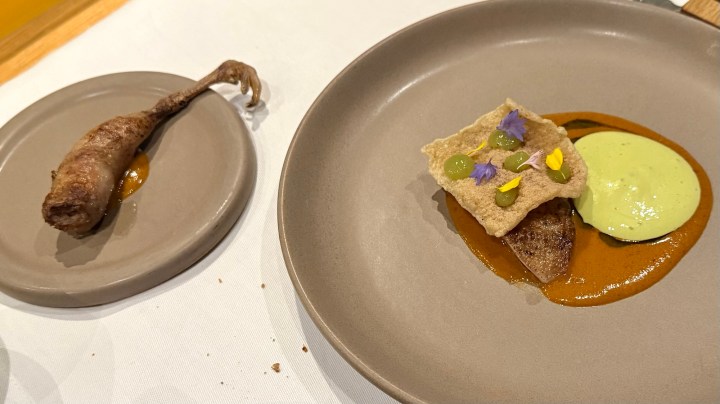
I forgot to take a photo of the next wine, which was a 2018 Brunello di Montalcino—another upgrade compared to the regular pairing of a 2012 Schioppettino from Friuli. Despite its youth, the Brunello was excellent. The Schioppettino, on the other hand, remained quite tannic even with its age. The dish was quail breast with a butter chicken sauce, wild garlic, and a quail leg stuffed with the bird’s heart and liver. The breast was served very pink, which I personally enjoy, though it might be off-putting to some. The butter chicken sauce was creamy and mildly spiced, acting as the dominant flavor in the dish, as quail itself is quite delicate. The Brunello paired quite well.
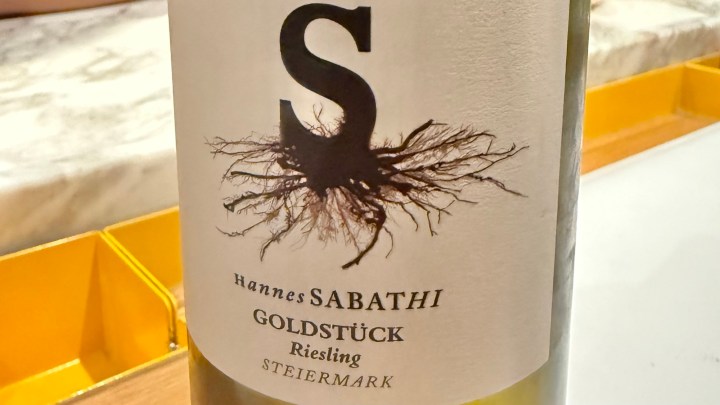
The dessert wine was a mildly sweet Riesling from Steiermark in Austria.

The dessert was peach with tomato and huacatay from the roof garden, also known as Peruvian black mint. It had a very subtle flavor and was only mildly sweet, yet even so, it was almost too sweet for the Riesling.
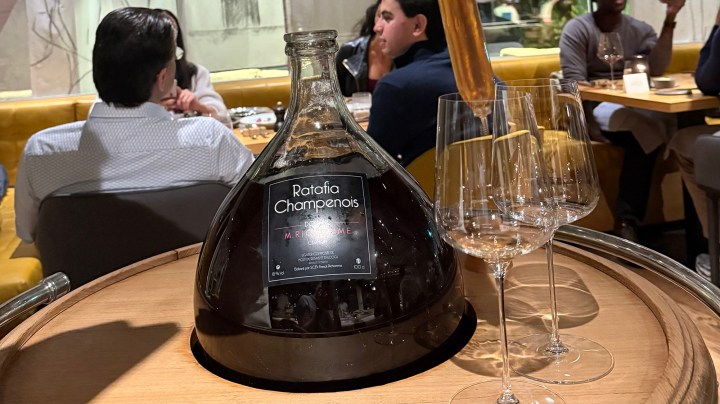
After dessert, we were served a complimentary Ratafia Champenois using a dropper. Ratafia is a blend of unfermented grape juice and grape alcohol—known as marc in French, though the Italian term grappa is more widely recognized. This particular Ratafia was made from Chardonnay grapes from Champagne and had an amber hue from aging. While Ratafia can be quite enjoyable, I didn’t particularly care for this one.

Coffee or tea was served with a treat resembling an Oreo cookie.
Although we had a view of the charcoal fire, the dishes in the chef’s menu didn’t feature much smoky flavor—which I would have appreciated. The flavors were either very subtle or driven mostly by spiciness, with very little salt. Personally, I prefer bolder flavors. The portions were quite small; a quail is a tiny bird, and the main course consisted of just half a quail. Still, we didn’t leave hungry thanks to the excellent crusty sourdough bread.
The wine pairings were good, but not exceptional. Restaurants often insist on serving a red wine with the main course, even when a full-bodied white would be a better match—likely because they assume that’s what guests expect. In this case, the quail would have paired better with a white like Condrieu. And if a red is necessary, a lighter one such as Pinot Noir would have been preferable to the Schioppettino. The sommelier didn’t seem to fully grasp my request to upgrade the wine pairing if possible, and appeared to interpret it as criticism of the regular pairing. My intention was simply to offer the opportunity to select wines without budget constraints, since pairings typically work within a fixed cost. That said, the pricing of the regular pairing was quite close to the food, which I appreciate, and the quality of the wines matched the level of the cuisine. But as a lover of good white Burgundy, I can’t resist when I see it on the list and it suits the dish.
Aside from the slightly awkward wine discussions, the service was friendly and attentive. We especially liked that many of the dishes were served by the kitchen staff themselves. We had a lovely evening at Wils, thanks in large part to the welcoming atmosphere of the restaurant, which made us feel right at home.


Anja and you both look well and, I am certain, had a wonderful birthday celebration. Interesting offerings perchance not quite as exciting as in some of the places you have visited. Somehow the quail dish presentation did not thrill. Thought of you in the middle of our last night on the first night of watching Vuelta a Espana bike race – began in absolutely beautiful Turin > am pretty certain you have been . . ,
LikeLiked by 1 person
Have certainly been to Turin; I’ve actually spent a week there in 2011 (if memory serves) for a private Italian language course.
LikeLiked by 1 person
It does look like an amazing treat!
LikeLiked by 1 person
You certainly dodged a bullet with the upgraded wine instead of the Niagara wine. While some of the wines of Niagara are fine, we find that more cost effective European wines are better.
What a lovely experience you gave to your friend, she must have enjoyed it very much.
LikeLiked by 1 person